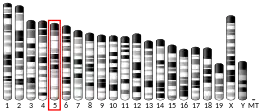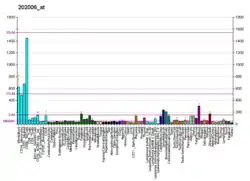PTPN12
Tyrosine-protein phosphatase non-receptor type 12 is an enzyme that in humans is encoded by the PTPN12 gene.[5][6]
The protein encoded by this gene is a member of the protein tyrosine phosphatase (PTP) family. PTPs are known to be signaling molecules that regulate a variety of cellular processes including cell growth, differentiation, mitotic cycle, and oncogenic transformation. This PTP contains a C-terminal PEST motif, which serves as a protein–protein interaction domain, and may be related to protein intracellular half-life. This PTP was found to bind and dephosphorylate the product of oncogene c-ABL, thus may play a role in oncogenesis. This PTP was shown to interact with, and dephosphorylate, various of cytoskeleton and cell adhesion molecules, such as p130 (Cas), CAKbeta/PTK2B, PSTPIP1, and paxillin, which suggested its regulatory roles in controlling cell shape and mobility.[6]
Interactions
PTPN12 has been shown to interact with BCAR1,[7][8][9][10] Grb2,[11] PSTPIP1,[12] TGFB1I1,[13] Paxillin[14][15][16] and SHC1.[17][18]
References
- GRCh38: Ensembl release 89: ENSG00000127947 - Ensembl, May 2017
- GRCm38: Ensembl release 89: ENSMUSG00000028771 - Ensembl, May 2017
- "Human PubMed Reference:". National Center for Biotechnology Information, U.S. National Library of Medicine.
- "Mouse PubMed Reference:". National Center for Biotechnology Information, U.S. National Library of Medicine.
- Takekawa M, Itoh F, Hinoda Y, Adachi M, Ariyama T, Inazawa J, Imai K, Yachi A (March 1994). "Chromosomal localization of the protein tyrosine phosphatase G1 gene and characterization of the aberrant transcripts in human colon cancer cells". FEBS Lett. 339 (3): 222–8. doi:10.1016/0014-5793(94)80420-6. PMID 7509295. S2CID 4885570.
- "Entrez Gene: PTPN12 protein tyrosine phosphatase, non-receptor type 12".
- Lin, Yi; Ceacareanu Alice Corina; Hassid Aviv (August 2003). "Nitric oxide-induced inhibition of aortic smooth muscle cell motility: role of PTP-PEST and adaptor proteins p130cas and Crk". Am. J. Physiol. Heart Circ. Physiol. 285 (2): H710–21. doi:10.1152/ajpheart.01127.2002. ISSN 0363-6135. PMID 12714323. S2CID 42587789.
- Garton, A J; Burnham M R; Bouton A H; Tonks N K (August 1997). "Association of PTP-PEST with the SH3 domain of p130cas; a novel mechanism of protein tyrosine phosphatase substrate recognition". Oncogene. 15 (8): 877–85. doi:10.1038/sj.onc.1201279. ISSN 0950-9232. PMID 9285683.
- Côté, J F; Charest A; Wagner J; Tremblay M L (September 1998). "Combination of gene targeting and substrate trapping to identify substrates of protein tyrosine phosphatases using PTP-PEST as a model". Biochemistry. 37 (38): 13128–37. doi:10.1021/bi981259l. ISSN 0006-2960. PMID 9748319.
- Garton, A J; Flint A J; Tonks N K (November 1996). "Identification of p130(cas) as a substrate for the cytosolic protein tyrosine phosphatase PTP-PEST". Mol. Cell. Biol. 16 (11): 6408–18. doi:10.1128/MCB.16.11.6408. ISSN 0270-7306. PMC 231642. PMID 8887669.
- Charest, A; Wagner J; Kwan M; Tremblay M L (April 1997). "Coupling of the murine protein tyrosine phosphatase PEST to the epidermal growth factor (EGF) receptor through a Src homology 3 (SH3) domain-mediated association with Grb2". Oncogene. 14 (14): 1643–51. doi:10.1038/sj.onc.1201008. ISSN 0950-9232. PMID 9135065.
- Dowbenko, D; Spencer S; Quan C; Lasky L A (January 1998). "Identification of a novel polyproline recognition site in the cytoskeletal associated protein, proline serine threonine phosphatase interacting protein". J. Biol. Chem. 273 (2): 989–96. doi:10.1074/jbc.273.2.989. ISSN 0021-9258. PMID 9422760.
- Nishiya, N; Iwabuchi Y; Shibanuma M; Côté J F; Tremblay M L; Nose K (April 1999). "Hic-5, a paxillin homologue, binds to the protein-tyrosine phosphatase PEST (PTP-PEST) through its LIM 3 domain". J. Biol. Chem. 274 (14): 9847–53. doi:10.1074/jbc.274.14.9847. ISSN 0021-9258. PMID 10092676.
- Shen, Y; Lyons P; Cooley M; Davidson D; Veillette A; Salgia R; Griffin J D; Schaller M D (January 2000). "The noncatalytic domain of protein-tyrosine phosphatase-PEST targets paxillin for dephosphorylation in vivo". J. Biol. Chem. 275 (2): 1405–13. doi:10.1074/jbc.275.2.1405. ISSN 0021-9258. PMID 10625692.
- Côté, J F; Turner C E; Tremblay M L (July 1999). "Intact LIM 3 and LIM 4 domains of paxillin are required for the association to a novel polyproline region (Pro 2) of protein-tyrosine phosphatase-PEST". J. Biol. Chem. 274 (29): 20550–60. doi:10.1074/jbc.274.29.20550. ISSN 0021-9258. PMID 10400685.
- Shen, Y; Schneider G; Cloutier J F; Veillette A; Schaller M D (March 1998). "Direct association of protein-tyrosine phosphatase PTP-PEST with paxillin". J. Biol. Chem. 273 (11): 6474–81. doi:10.1074/jbc.273.11.6474. ISSN 0021-9258. PMID 9497381.
- Habib, T; Herrera R; Decker S J (October 1994). "Activators of protein kinase C stimulate association of Shc and the PEST tyrosine phosphatase". J. Biol. Chem. 269 (41): 25243–6. doi:10.1016/S0021-9258(18)47237-7. ISSN 0021-9258. PMID 7929214.
- Charest, A; Wagner J; Jacob S; McGlade C J; Tremblay M L (April 1996). "Phosphotyrosine-independent binding of SHC to the NPLH sequence of murine protein-tyrosine phosphatase-PEST. Evidence for extended phosphotyrosine binding/phosphotyrosine interaction domain recognition specificity". J. Biol. Chem. 271 (14): 8424–9. doi:10.1074/jbc.271.14.8424. ISSN 0021-9258. PMID 8626541.
Further reading
- Takekawa M, Itoh F, Hinoda Y, et al. (1993). "Cloning and characterization of a human cDNA encoding a novel putative cytoplasmic protein-tyrosine-phosphatase". Biochem. Biophys. Res. Commun. 189 (2): 1223–30. doi:10.1016/0006-291X(92)92335-U. PMID 1472029.
- Yi T, Cleveland JL, Ihle JN (1991). "Identification of novel protein tyrosine phosphatases of hematopoietic cells by polymerase chain reaction amplification". Blood. 78 (9): 2222–8. doi:10.1182/blood.V78.9.2222.2222. PMID 1932742.
- Garton AJ, Tonks NK (1994). "PTP-PEST: a protein tyrosine phosphatase regulated by serine phosphorylation". EMBO J. 13 (16): 3763–71. doi:10.1002/j.1460-2075.1994.tb06687.x. PMC 395289. PMID 7520867.
- Habib T, Herrera R, Decker SJ (1994). "Activators of protein kinase C stimulate association of Shc and the PEST tyrosine phosphatase". J. Biol. Chem. 269 (41): 25243–6. doi:10.1016/S0021-9258(18)47237-7. PMID 7929214.
- Yang Q, Co D, Sommercorn J, Tonks NK (1993). "Cloning and expression of PTP-PEST. A novel, human, nontransmembrane protein tyrosine phosphatase". J. Biol. Chem. 268 (23): 17650. doi:10.1016/S0021-9258(19)85383-8. PMID 8349645.
- Yang Q, Co D, Sommercorn J, Tonks NK (1993). "Cloning and expression of PTP-PEST. A novel, human, nontransmembrane protein tyrosine phosphatase". J. Biol. Chem. 268 (9): 6622–8. doi:10.1016/S0021-9258(18)53296-8. PMID 8454633.
- Charest A, Wagner J, Jacob S, et al. (1996). "Phosphotyrosine-independent binding of SHC to the NPLH sequence of murine protein-tyrosine phosphatase-PEST. Evidence for extended phosphotyrosine binding/phosphotyrosine interaction domain recognition specificity". J. Biol. Chem. 271 (14): 8424–9. doi:10.1074/jbc.271.14.8424. PMID 8626541.
- Garton AJ, Flint AJ, Tonks NK (1996). "Identification of p130(cas) as a substrate for the cytosolic protein tyrosine phosphatase PTP-PEST". Mol. Cell. Biol. 16 (11): 6408–18. doi:10.1128/MCB.16.11.6408. PMC 231642. PMID 8887669.
- Charest A, Wagner J, Kwan M, Tremblay ML (1997). "Coupling of the murine protein tyrosine phosphatase PEST to the epidermal growth factor (EGF) receptor through a Src homology 3 (SH3) domain-mediated association with Grb2". Oncogene. 14 (14): 1643–51. doi:10.1038/sj.onc.1201008. PMID 9135065.
- Garton AJ, Burnham MR, Bouton AH, Tonks NK (1997). "Association of PTP-PEST with the SH3 domain of p130cas; a novel mechanism of protein tyrosine phosphatase substrate recognition". Oncogene. 15 (8): 877–85. doi:10.1038/sj.onc.1201279. PMID 9285683.
- Dowbenko D, Spencer S, Quan C, Lasky LA (1998). "Identification of a novel polyproline recognition site in the cytoskeletal associated protein, proline serine threonine phosphatase interacting protein". J. Biol. Chem. 273 (2): 989–96. doi:10.1074/jbc.273.2.989. PMID 9422760.
- Shen Y, Schneider G, Cloutier JF, et al. (1998). "Direct association of protein-tyrosine phosphatase PTP-PEST with paxillin". J. Biol. Chem. 273 (11): 6474–81. doi:10.1074/jbc.273.11.6474. PMID 9497381.
- Côté JF, Charest A, Wagner J, Tremblay ML (1998). "Combination of gene targeting and substrate trapping to identify substrates of protein tyrosine phosphatases using PTP-PEST as a model". Biochemistry. 37 (38): 13128–37. doi:10.1021/bi981259l. PMID 9748319.
- Wu Y, Dowbenko D, Lasky LA (1998). "PSTPIP 2, a second tyrosine phosphorylated, cytoskeletal-associated protein that binds a PEST-type protein-tyrosine phosphatase". J. Biol. Chem. 273 (46): 30487–96. doi:10.1074/jbc.273.46.30487. PMID 9804817.
- Sanger Centre, The; Washington University Genome Sequencing Cente, The (1999). "Toward a complete human genome sequence". Genome Res. 8 (11): 1097–108. doi:10.1101/gr.8.11.1097. PMID 9847074.
- Li J, Nishizawa K, An W, et al. (1999). "A cdc15-like adaptor protein (CD2BP1) interacts with the CD2 cytoplasmic domain and regulates CD2-triggered adhesion". EMBO J. 17 (24): 7320–36. doi:10.1093/emboj/17.24.7320. PMC 1171078. PMID 9857189.
- Garton AJ, Tonks NK (1999). "Regulation of fibroblast motility by the protein tyrosine phosphatase PTP-PEST". J. Biol. Chem. 274 (6): 3811–8. doi:10.1074/jbc.274.6.3811. PMID 9920935.
- Angers-Loustau A, Côté JF, Charest A, et al. (1999). "Protein Tyrosine Phosphatase-PEST Regulates Focal Adhesion Disassembly, Migration, and Cytokinesis in Fibroblasts". J. Cell Biol. 144 (5): 1019–31. doi:10.1083/jcb.144.5.1019. PMC 2148201. PMID 10085298.
- Nishiya N, Iwabuchi Y, Shibanuma M, et al. (1999). "Hic-5, a paxillin homologue, binds to the protein-tyrosine phosphatase PEST (PTP-PEST) through its LIM 3 domain". J. Biol. Chem. 274 (14): 9847–53. doi:10.1074/jbc.274.14.9847. PMID 10092676.





